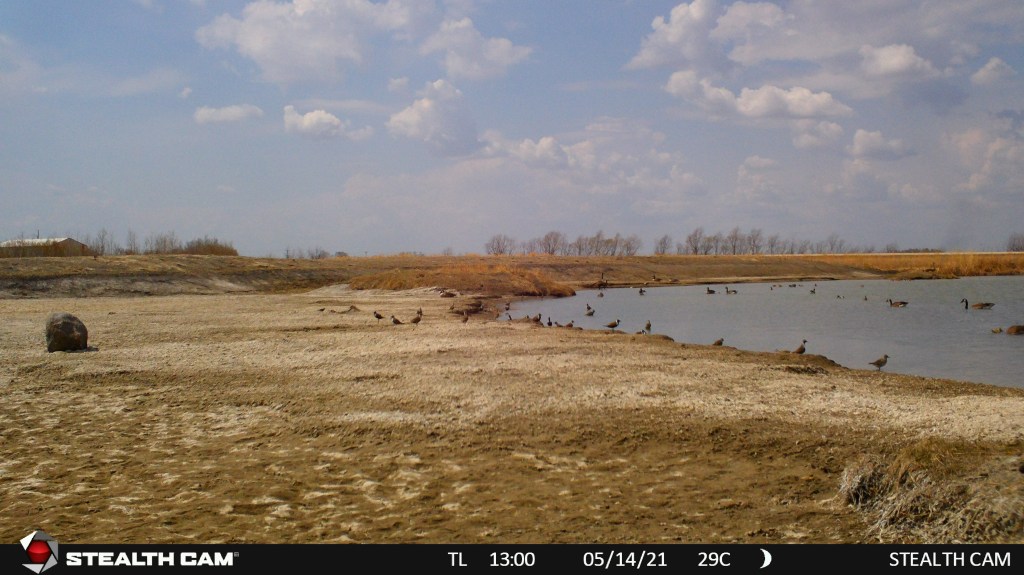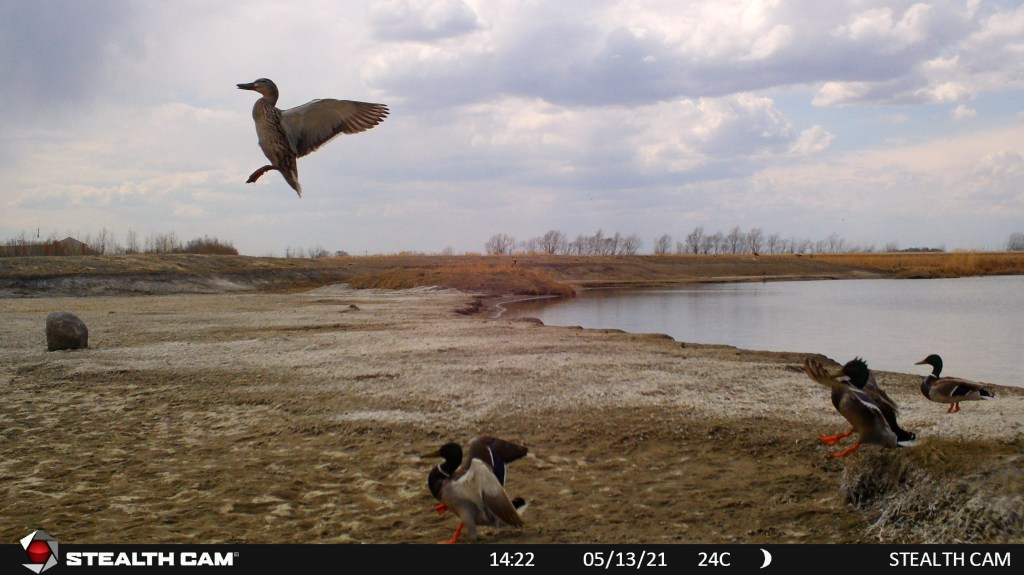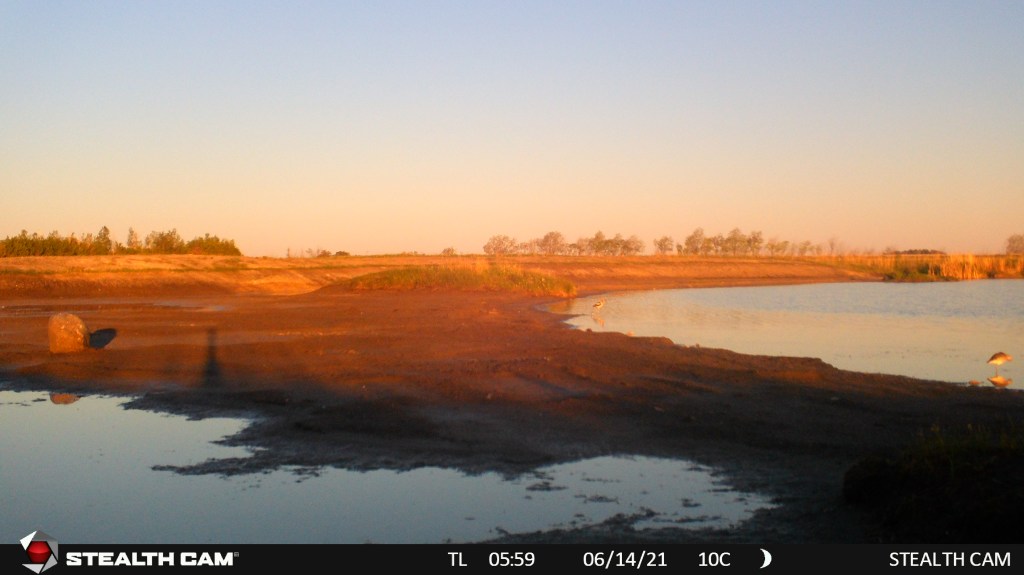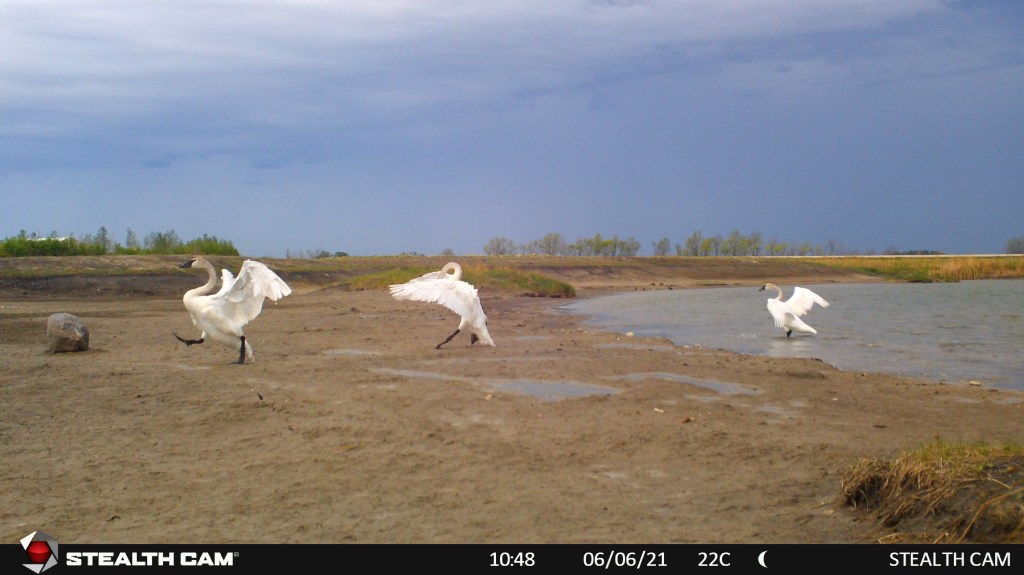Our first update of what was seen from the Trail Camera at the shorebird scrape was back in mid-May. Here we are covering from mid-May into June, including some peak shorebird migration timing!
As the shorebirds turn up where they turn up, we can’t always identify them from the photos. They are often too far away from the trail camera (which is limited by the resolution)! Often, we can tell from the silhouette the general type of bird (shorebird, duck, etc.).
Starting off with the end of May. May 12th, we had some wild temperature swings according to the trail camera, with a low of -2 degrees at 5:30am and a high of +30 at 4:30pm! We had 1 unknown shorebird and 2 American Avocets
In general, American Avocets are some of our most commonly identified shorebirds in the trail camera – likely due in part to their stand-out coloration and size that makes them easy to see even with the trail camera resolution. Avocets were at the scrape May 12 (see above), May 14 and May 16-19. It was always a pair of Avocets. They are a species that breeds in southern Manitoba, so this could be a breeding pair, if indeed it is always the same individuals.
We had Godwits show up multiple times – very likely Marbled Godwits. We also had one really great photo of a Marbled Godwit showing its beautiful cinnamon underwing! Godwits showed up at the scrape on May 14 (5 individuals), May 15 and May 19.

There were a couple exciting days on May 14th, May 15th and May 17th where Golden Plovers showed up. At my best count there were 27 on May 14th, 10 or so on May 15th and 11 on May 17th.

There were also Yellowlegs on May 13-15 (between 1-4 individuals) and May 18th (1 individual). There were likely more Yellowlegs mixed in with the various “unknown” shorebirds listed below.
Other shorebirds that showed up in this period include a single Willet (May 17th), Killdeer (1 on May 16, 2 on May 17th) and Wilson’s Phalaropes (2 on May 14th, and 3 on May 17th).
By far the largest category of shorebirds, was unfortunately those that were not identifiable. We had a total of at least 29 mystery shorebirds using the scrape in May.
In terms of other water and wetland birds species using the scrape there were a variety of waterfowl such as Swans, Canvasbacks, Redheads, Northern Shovelers, Mallards, Canada Geese (with young), Scaup, Yellow-headed Blackbirds, Red-winged Blackbirds, a Franklin’s Gull and and an unidentifiable species of grebe.


The number and diversity of species decreased in June. The beginning of June is still part of the spring shorebirds migration (for example the International Shorebird Survey ends June 15th) however, the later half of June is firmly in the breeding bird season.
Not surprisingly we had Killdeer show up a lot on our trail cameras. We caught Killdeer on all but 10 days in June (and some of those days had unidentifiable shorebirds, which could have been Killdeer). There was only ever a maximum of two Killdeer, so perhaps a pair that was breeding nearby.

Other shorebird species that breed in southern Manitoba that showed up quite often in early June were the American Avocet and Marbled Godwit. The American Avocet was seen on June 4 (4 individuals) June 5 (one individual), June 9th (1 individual), and June 14th (2 individuals). Marbled Godwits were seen on June 6 (2 individuals), June 15 (6 individuals), June 16 (2 individuals) and June 17 (1 individual). There was one identifiable Willet who visited on June 7th.

Similar to May, the number of shorebirds using the scrape is higher than my numbers above for June suggest due to the difficultly in identification, as well as likely missing some individuals due to how well many camouflage with their surroundings! In June I had 34 mystery shorebirds.
Other bird species seen on the scrape in June were Canada Geese (adults and young), Swans, Mallards, Redheads, Blue-winged Teal, Yellow-headed Blackbirds, Red-winged Blackbirds, Northern Shovelers, Tree Swallows and a Black-billed Magpie.

In total for May and June there were 7 species of shorebirds identified, and at least 14 other non-shorebird species.
Something else to touch on this year is the lack of water at the shorebird scrape and in the associated pond! We started the spring with very little snow on the ground to melt, and therefore very little spring runoff to feed the scrape and the pond. Then, as everyone knows, we have had very hot and dry weather for a large portion of the summer. In June, for example, I had two instances of rain show up on the trail camera – June 9th and June 19th! As a result, the scrape is completely dry, and water levels in the pond are low. It has certainly been an interesting year to observe how our target species are using the shorebird scrape.


We are now just moving into the start of fall shorebird migration, as the yearly cycle of migratory shorebirds begins again. If you are interested in volunteering for or learning more about the International Shorebirds Survey (ISS) please send an email to iba@naturemanitoba.ca. We have ISS routes at Oak Lake/ Plum Lakes IBA, Whitewater Lake IBA, the Shoal Lakes IBA and Oak Hammock Marsh.
-Amanda